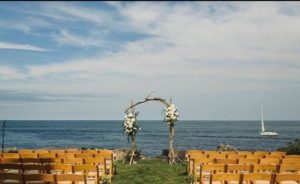Here's a good article on traditional wedding dress fabrics by Jolene M. Bouchon from Brides Magazine. Not all wedding dress fabrics are created equally. Some... Read More

Here’s a good article on traditional wedding dress fabrics by Jolene M. Bouchon from Brides Magazine.
Not all wedding dress fabrics are created equally. Some fabrics are better suited for structured designs, others are great for flowing, light looks, and others for larger-than-life ballgowns. Before you jump into wedding dress shopping, learn what to expect when it comes to fabric. We talked to Terry Hall, fashion director at Kleinfeld Bridal in New York, about the six fabrics most often used to create wedding dresses and why they work. Read on to learn more about these gorgeous fabrics and why they each make an excellent choice for gowns.
- Satin
It’s a common misconception, says Hall, but “satin” is not a fiber. It’s a finish. You can have satin that’s made of pure silk, all polyester, or a blend. The same is true for lace, tulle, taffeta — almost any fabric. In general, fabrics made from natural fibers breathe better, but they can also be more expensive or wrinkle more easily, thus blends and synthetics.
Satin is one of the most common, most versatile, and most durable wedding dress fabrics. Satin has a smooth finish with a lot of body, making it perfect for more structured gowns. It’s a supportive fabric that works with every body type and is a good choice for ruched, draped, and ball gown styles. And because it tends to be a thicker fabric, it’s also a good choice for cooler weather weddings, particularly duchess satin. Most bridal satin tends to be 100 percent silk.
- Charmeuse
Charmeuse is is a light, rich fabric with a lovely drape and a glossy sheen. It is usually made of silk, but can also be made from synthetic fibers. “Charmeuse has a gorgeous liquid effect that’s slinky, but it’s not so forgiving,” says Hall. Most often cut on the bias (diagonally across the grain to encourage it’s drape) and used in column dresses, charmeuse is incredibly luxurious, but it does show every flaw.
- Chiffon
Incredibly sheer and lightweight, chiffon is a light woven fabric. Because it’s so sheer, it’s often used in layers or as an overlay for a more substantial fabric. This delicate fabric has a floaty, weightless look, but it does fray and snag easily.
- Organza
Organza is a sheer, lightweight woven fabric traditionally made from silk. Organza, however, is much stiffer than chiffon. Whereas chiffon drapes, organza is more structured, though still light and ethereal, making it perfect for warmer weather weddings. It, too, is a very delicate fabric, so watch out for snags and pulls.
- Tulle
You know the light, netlike fabric that ballerina’s tutus are made of? That’s tulle. Tulle is sheer with an open weave that looks like netting. The fabric can incorporate lace designs, as well. According to Hall, a ball gown style made of tulle will have a diaphanous, airy feeling, but ruching it will give it more structure. Either way, it’s an incredibly delicate fabric, easily snagged on jewelry.
- Lace
Lace is one of the wedding dress materials that adds so much grace to any gown. Most often used as an overlay or detail, lace comes in a startling variety of styles. As with tulle, the open weave makes it susceptible to snags. Lace is typically named for the city where they it was originally produced. Some of the more popular varieties of lace are:
- Chantilly: a very detailed, open lace with a defined border
- Alençon: a lace featuring bold motifs on the net, and trimmed with cord
- Venise: a heavier and more textured lace that is often used in winter weddings
Other Wedding Dress Fabric Types
While you can find other fabrics beyond satin, charmeuse, chiffon, organza, tulle and lace, these are the most traditional fabrics used for wedding dresses. Hall notes that interest in certain types of silk (mikado, radzmir and gazar) is on the rise. Notably, gazar is what Kate Middleton’s wedding dress was made from. Other hot trends for wedding dress material types, according to Hall, include creative and artistic tattoo and laser-cut laces, which nod to the traditional while still being fresh and modern.
